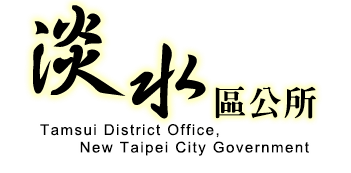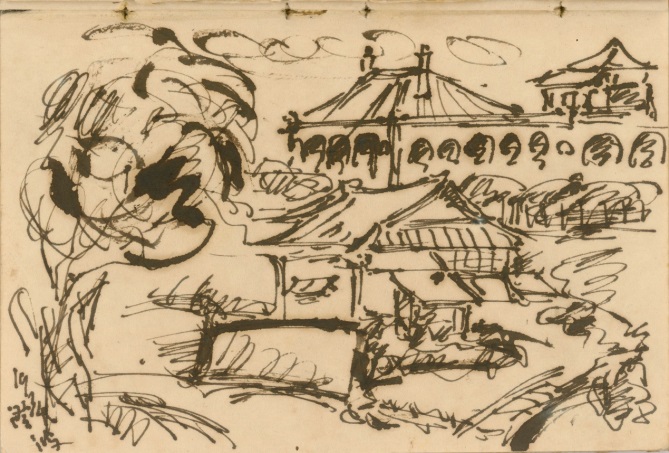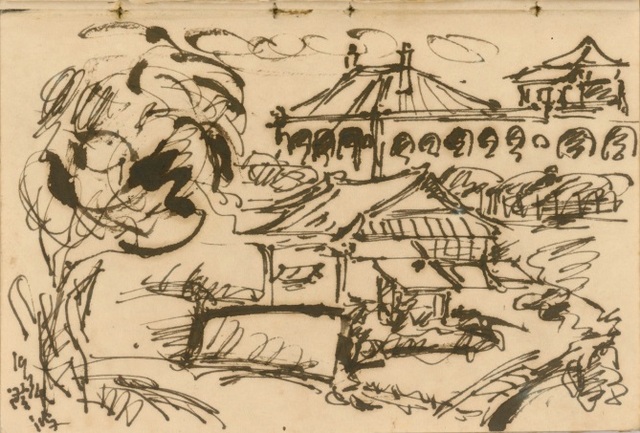畫作名稱
風景速寫(116)-SB18:34 1934 紙本鋼筆 12.5×18.5cm 私人收藏
Landscape Sketch (116)-SB18:34 1934 Pen and ink on paper 12.5×18.5cm Private collection.
風景スケッチ(116)-SB18:34 1934年 紙、万年筆 12.5×18.5cm 個人蔵
畫作解析
歷史不只保存在文獻與古蹟當中,有時也在畫家的素描簿裡留下雪泥鴻爪,這幀景物速寫就是一例。比對老照片,圖中所描繪的建築物,應是二戰期間消失的淡水「黑樓」,以及現存的淡水街長多田榮吉故居。
Not only is history preserved in documents and heritage sites, but vestiges of history also remain in a painter’s sketchbooks. This landscape sketch is a good example. Compared with the old photographs of Tamsui, the two structures depicted in the sketch must be the “Black House,” which had disappeared during World War II, and the existing residence previously owned by Tada Eikichi, the Head of Tamsui Street.
歴史は文献や古跡にのみ保存されているのではない。画家がスケッチブックにその痕跡を残すこともある。この風景のスケッチはその一例である。当時の写真と見くらべてみると、描かれている二つの建物は、第二次世界大戦中に失われた黒楼と現存する淡水街長多田栄吉旧宅にちがいない。
遠景的洋樓,外觀有成排醒目的拱圈,乍看與淡水的知名歷史建築「小白宮」頗為近似。不過,若比對日本時代的老照片,畫中建物的特徵,應與1940年代以前存在於小白宮南側、老淡水人稱作「黑樓」的洋房較為相符。
In the background, the Western-style house with striking rows of arches on the exterior looks, at first glance, exactly like the Little White House, a famous historic building at Tamsui. However, compared with the old photographs from the Japanese colonial period, the characteristics of the pictorial building correspond more closely to those of the so-called “Black House,” a Western-style house known to the old locals at Tamsui. The Black House had existed to the south of the Little White House till 1940.
遠方の西洋建築は、目を引くアーチの連なりを見るに、有名なリトルホワイトハウス(小白宮)に似ている。ただ、日本統治期の写真と対照してみると、1940年代まで小白宮の南側にあり、昔の淡水を知る住民が黒楼と呼ぶ洋館により近い。
黑樓的故事與小白宮相仿,兩幢建物皆由清末淡水的稅務司所興建,日本時代亦同屬淡水稅關所有。1930年代末,這兩棟洋房都淪落為破敗的空屋,而在二戰末期美軍的淡水空照圖裡,黑樓已然消失於地表。有關黑樓的史料十分罕見,這幅畫記錄了它在1934年的樣貌,為歷史留下珍貴的側寫。
The Black House and the Little White House have a similar story: both buildings were constructed by the Tamsui Tax Department at the end of the Qing Dynasty, and both belonged to the Tamsui Customs Office during the Japanese rule period. In the late 1930s, both Western-style houses were deserted and run-down. Near the end of World War II, the Black House had disappeared from the earth in an aerial photograph taken by the American army. Rarely can we find any historical data about the Black House; notwithstanding, this drawing records its appearance in 1934 and thus leaves a valuable profile of the Black House in history.
黒楼はリトルホワイトハウスと同じく、清朝期末期に淡水税務司によって建てられた。日本統治期には淡水税関が所有していたが、1930年代末には両者とも荒れ果てた空き家になってしまい、第二次世界大戦末期に米軍が撮影した航空写真には、すでに黒楼の姿はない。黒楼の史料は非常に少なく、1934年のこの素描は貴重な歴史の証言者である。
近景的日式建築有兩條小徑環繞,考慮其外觀與相對位置,應是日人多田榮吉的住宅。陳澄波作成這幅速寫的年代,這棟房子剛剛完工 ,多田先生也從淡水街長(亦即當時淡水地區的行政首長)一職卸任不久。他與家人長居於此處,直到二戰結束返日為止。
In the foreground, the Japanese-style structure is circled by two paths. In view of its exterior and the relative position, it must be the former residence of Tada Eikichi. Chen Cheng-po made this sketch in the year when the construction work of the house was newly completed, and shortly before Mr. Tada was relieved of his office as the Head of Tamsui Street (i.e. the administrative chief of Tamsui Township at that time).1 Mr. Tada and his family had lived in this residence until they returned to Japan at the end of World War II.
二本の小道に囲まれている近景の日本家屋は、外観や位置から判断すると多田栄吉宅であろう。このスケッチが描かれたころ多田宅は建てられたばかりで1、多田が淡水街長(当時の淡水地区の首長)を退任してまもないころだった。彼の一家は終戦後、日本へ戻るまでここに住んだ。
往昔歷史的片片段段,總在不經意處遺留線索。每當陳澄波打開素描本子,時光便藉著他的筆墨,流轉於紙頁上。不只構築了一幅畫,也寫下了故事。
Bits of the past history have left their traces unexpectedly. Whenever Chen Cheng-po opened a sketchbook, landscapes of the time would be transmitted onto the paper via his pen and ink. He not only constructed a painting but also wrote down a story.
歴史の一こま一こまは、往々にして思わぬところに探索のかぎを残すものである。陳澄波のスケッチブックを開けるたびに、時間が彼の筆の跡に乗って紙の上に流れる。彼は、絵のみならず物語をも書き上げていたのである。



